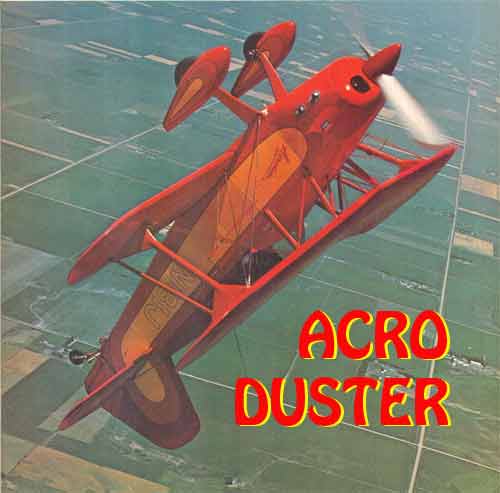 |
Acroduster
One : A Pitts Killer or a Pitts Wannabee? |
PAGE TWO
Basically, if you were to put the two airplanes side by side and begin comparing structures, about the only concepts that the two airplanes would appear to agree upon would be two wings, one Lycoming, three wheels and a bucket of AN bolts. They may both be biplanes, but they are only distant cousins. As I S-turned down the taxiway towards the end of the runway, it was interesting to note that the hump-back, flat-bottom fuselage of the 'duster gives excellent visibility. With a little neck craning it's actually possible to peek directly over the nose. However, I prefer to sit a bit lower to keep my curly eyebrows out of the slipstream when doing something dumb, like an outside loop. This lower position didn't affect visibility significantly. Then came the takeoff. This was my first hint that the lighter span-loading of the Acroduster (two feet more span than a Pitts with the same weight) and the greater gap on the wings was going to make it a nifty little lifting machine. It actually flew itself off the ground on its wings, giving a subtle feeling that it wasn't depending entirely on the engine to climb. It just trundled straight down the runway and took off almost before I had a chance to lift the tail. A takeoff in a Pitts is one of life's true thrills. It's a fun trip in a double-decked fuel dragster that accelerates at a blinding rate and screams down the runway for what seems an eternity of rudder corrections. The Acroduster has none of the kidney-squeezing excitement, of the Pitts, but it's fun just the same. And does it ever climb! I timed it at 3000-3100 feet per minute, which is at least as good as most Pitts. Rate of climb will vary with each plane's weight, Pitts and Acroduster, but only the lightest 200-hp Pitts will top that kind of climb. Part of Osborne's design philosophy was "build it light, make it lift," some of which can work against developing high roll rates with light stick pressures. Any extra wing slows down the roll (roll rate depends on a fourth power function of which the span is a part,) which demands larger, more effective ailerons, which means more control system weight, etc., etc. But whatever the negatives, Osborne stirred big ailerons, aerodynamic balances, and control ratios into such a sweet mixture that it actually surprised me the first time I made a turn. The response and rate of roll were much, much higher than I expected. Twisting it around in slow rolls is something my young son could handle, but if you want to add some high-grade excitement to your day, try a full deflection roll! I had scoffed at Osborne's claims of 240 degree per second roll rates, but I was less than halfway around my first roll when I quit scoffing. With the ailerons against the stop, it appears to roll significantly faster than a Pitts at the same airspeed, and the Pitts is no rocking chair. It'd take a billion words to describe the next forty minutes I put on the Acroduster. I did just about everything I knew how to do in an airplane except a vertical octerflugeron with an outside yodel at the top, and the airplane made me look good all the way through. Four-points, eight-points, vertical four-points, inside-outside eights, outside rolling three-sixties and a nearly effortless (if four negative Gs can be called effortless) outside pushup into a vertical roll with a very long line at the top before hammer-heading out. The airplane has no limitations other than the pilot. I couldn't find any maneuver that I'd say was a giant leap ahead of the Pitts, but I will have to say that I found the airplane "easier" in some areas. Although the controls were no lighter and the elevators got pretty horsey due to the lack of an elevator trim (why, I don't know), it somehow seemed like it took less technique to do certain maneuvers well in the Acroduster. Snap rolls, for instance, were simple yank and stomp affairs that threatened to move both eyes to one side of my nose. The Pitts, regardless of how its snaps look, is not an airplane that does consistently good snap rolls without a certain amount of technique. The Acroduster just rips on around no matter what you do and a violent forward stab of the stick and opposite rudder stops it on a nickel. Hammerheads were the same way: easy! The Pitts asks that you watch things very closely on the way up to be certain that the outside wing doesn't get the best of you and roll you slightly inverted. The Acroduster doesn't seem to be quite that critical. It's not that it does maneuvers better. It just does them easier. On the negative side, the Acroduster didn't seem to be able to fly away as easily from a nearly stalled condition, such as pushing out at the top of a vertical roll. A Pitts has the very best slow speed characteristics and stall recovery of any airplane I've seen and will hang in there to the last second and still be able to motor away. The Acro seems to need that extra mph or two to be comfortable and not let a wing get down. |
